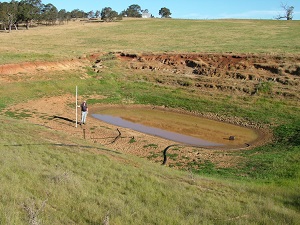Understand and monitor farm water needs

A dry spring in 2014 resulted in limited run-off into dams across western and central Victoria. Evaporation from farm dams can also result in significant water losses. The total annual evaporative loss from a three-metre deep dam could be up to 50 per cent of the dam's total storage volume.
The department provides an online Farm water calculator that can help farmers work out how much water is used on the property and how long the water will last.
To undertake a property water budget, farmers need to list all the dams by paddock and calculate the water available in each dam. The total water available on the property is then compared with the total water required by stock. The calculator allows for different classes of stock and their different drinking amounts. For example:
- lactating ewes on dry feed in summer require up to 14 litres per day
- mature sheep on dry pasture up to 9.8 litres per day
- beef cattle up to 98 litres per day.
For more information on using the farm water calculator contact Heather Field on (03) 5336 6607.
Water quality
Water quality should be monitored regularly, particularly if water levels are low (in summer or in periods of prolonged moisture stress), or there is potential for pollutants such as manure and soil to enter water sources. Dry conditions can lead to water quality issues such as high levels of salt. Young sheep have difficulty thriving on water supplies with a salt concentration higher than 5000 parts per million (ppm), whereas adult stock handle up to 10,000 ppm. Evaporation increases the salt concentration. A flush of water dilutes salts but may increase levels of sediment and fertilisers, and manure or nutrient run-off.
Water samples can be tested for salt content at your local department office or with do-it-yourself EC (electrical conductivity) meters.
Algae and animal manure can also foul water following heavy summer rains. During periods of low rainfall if pasture cover has fallen to critical levels, windborne dung and other organic materials may blow into dams. Rainstorms can also wash such materials into dams. Once in the water, these organic materials provide ideal food for bacteria and algae, which grow rapidly, using up the free oxygen in the water (it becomes anaerobic) — the result is putrefaction.
Symptoms are:
- dark water
- a bad smell
- black scum around the edge.
Stock find the water unpalatable, and thick scum around the water's edge may prevent stock from accessing the water. Evidence suggests that putrefied water is not poisonous to healthy sheep, but may be harmful to the young or the weak.
One class of algae — the blue-green algae — does produce toxins that can kill stock. If this occurs, stock need to be kept away from affected dams.
Preventing organic matter from reaching a dam
The best way to prevent organic matter from reaching a dam is to maintain an adequate vegetative cover around the dam, using permanent vegetated filter zones that are excluded from general grazing.
Where vegetation has already suffered, protective structures could be used. These include:
- netting fences
- corrugated iron fences
- earth banks.
Different designs are required for structures aimed at windborne materials and waterborne materials.
Where soils are suitable, ripping of bared areas can reduce movement of organic materials. (see Landcare Note LC0076: Protecting the land in dry times.)
If you have been affected by bushfires or just have bare hills feeding into dams, easily built sediment fences can help protect the quality of the water entering the dams. Sediment fences have been used effectively to stop materials such as ash, soil and manure from entering water supplies after the first big rain.
A practical 'how to' video has been produced for landholders on how to build sediment fences from wire, straw or mesh. You can also view or download a printable guide.